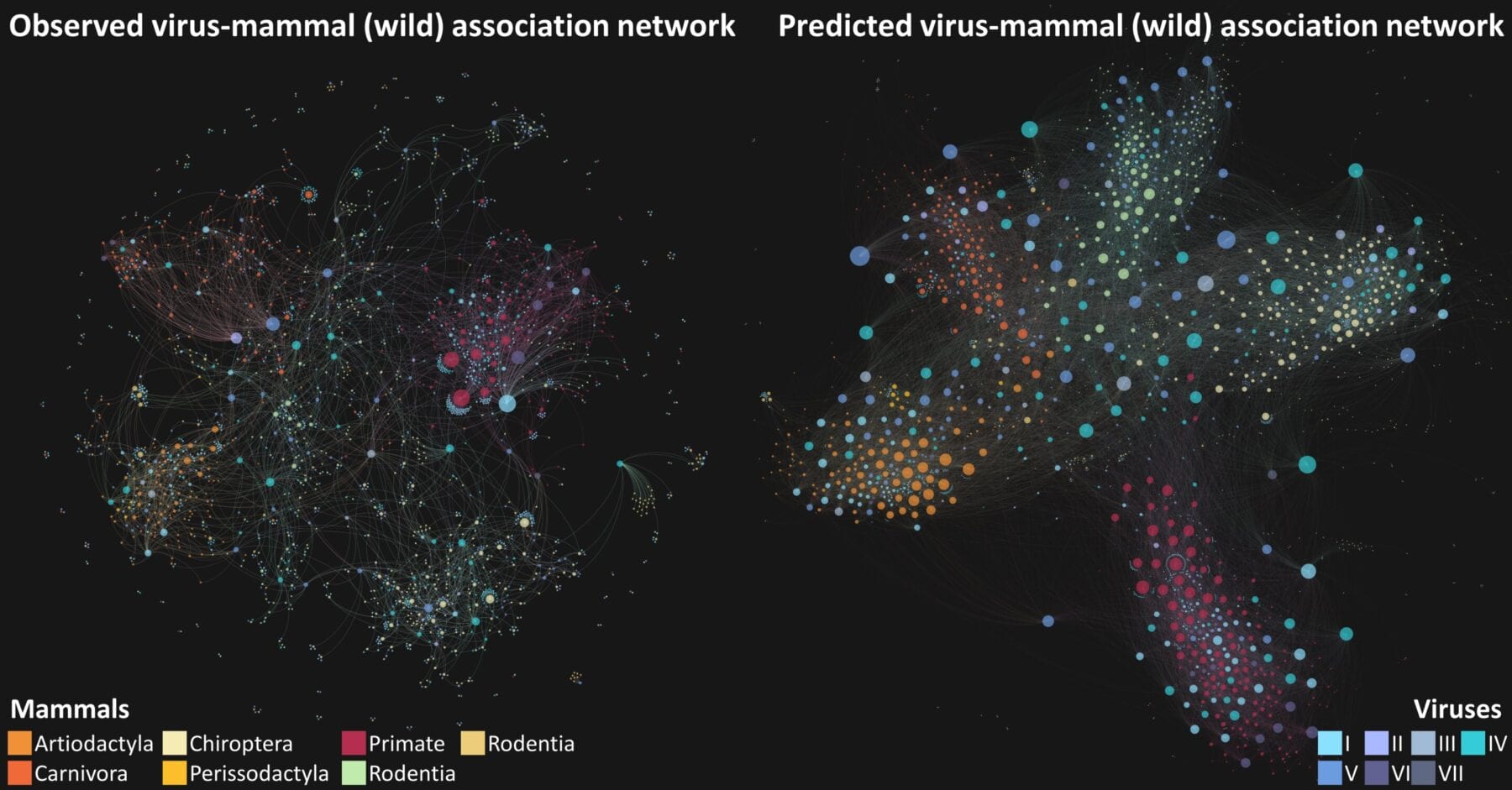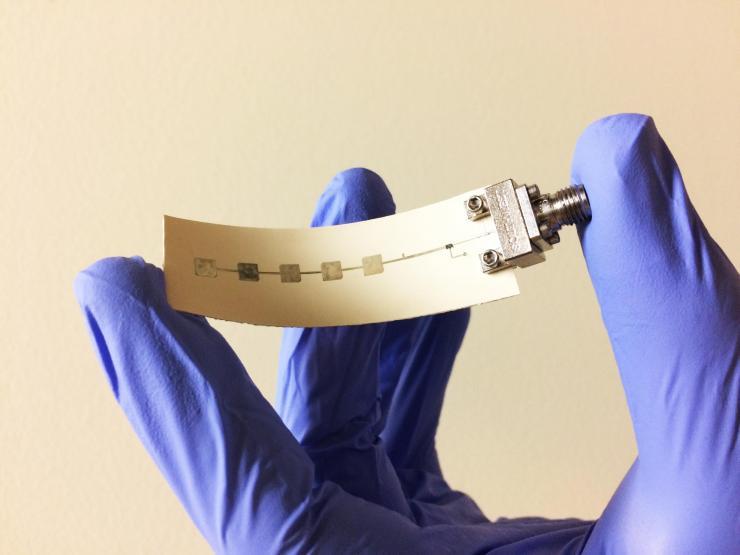
Abstract representation of networks of (1) observed and (2) predicted associations between wild and semi-domesticated mammalian hosts and known virus species.
(credit: Dr Maya Wardeh)
A new University of Liverpool study could help scientists mitigate the future spread of zoonotic and livestock diseases caused by viruses.
Researchers have used a form or artificial intelligence (AI) called machine-learning to predict more than 20,000 unknown associations between known viruses and susceptible mammalian species. The findings, which are published in Nature Communications, could be used to help target disease surveillance programmes.
Thousands of viruses are known to affect mammals, with recent estimates indicating that less than 1% of mammalian viral diversity has been discovered to date. Some of these viruses such as human and feline immunodeficiency viruses have a very narrow host range, whereas others such as rabies and West Nile viruses have very wide host ranges.
“Host range is an important predictor of whether a virus is zoonotic and therefore poses a risk to humans. Most recently, SARS-CoV-2 has been found to have a relatively broad host range which may have facilitated its spill-over to humans. However, our knowledge of the host range of most viruses remains limited,” explains lead researcher Dr Maya Wardeh from the University’s Institute of Infection, Veterinary and Ecological Sciences.
To address this knowledge gap, the researchers developed a novel machine learning framework to predict unknown associations between known viruses and susceptible mammalian species by consolidating three distinct perspectives – that of each virus, each mammal, and the network connecting them, respectively.
Their results suggests that there are more than five times as many associations between known zoonotic viruses and wild and semi-domesticated mammals than previously thought. In particular, bats and rodents, which have been associated with recent outbreaks of emerging viruses such as coronaviruses and hantaviruses, were linked with increased risk of zoonotic viruses.
The model also predicts a five-fold increase in associations between wild and semi-domesticated mammals and viruses of economically important domestic species such as livestock and pets.
Dr Wardeh said: “As viruses continue to move across the globe, our model provides a powerful way to assess potential hosts they have yet to encounter. Having this foresight could help to identify and mitigate zoonotic and animal-disease risks, such as spill-over from animal reservoirs into human populations.”
Dr Wardeh is currently expanding the approach to predict the ability of ticks and insects to transmit viruses to birds and mammals, which will enable prioritisation of laboratory-based vector-competence studies worldwide to help mitigate future outbreaks of vector-borne diseases.
Original Article: AI used to predict unknown links between viruses and mammals
More from: University of Liverpool
The Latest Updates from Bing News & Google News
Go deeper with Bing News on:
Links between viruses and mammals
- Avian influenza likely here to stay, regulations put on cattle transports across state lines
While the disease has not reached cattle in Kentucky, it has been detected in 36 dairy herds across nine states.
- There's no question H5N1 bird flu has 'pandemic potential.' How likely is that worst-case scenario?
For several decades, scientists have rung alarms that a dangerous form of bird flu had pandemic potential. As H5N1 spreads to more species, including U.S. dairy cattle, how likely is that worst-case ...
- Case report bolsters evidence for H5N1 avian flu spread from cow to Texas dairy worker
Scientists from the Centers for Disease Control and Prevention (CDC) and their collaborators in Texas today shared new details about an investigation into a recently reported H5N1 avian flu infection ...
- How does bird flu affect other species? UI professor explains
Ever since a rare human case emerged in Texas last month, talk of the H5N1 virus — also known as bird flu — has been spreading around almost as much as the virus has. But why does the bird flu affect ...
- How humans can and can’t catch bird flu
The virus has ... to a new mammal species is concerning. An outbreak of bird flu among cattle herds in the United States led to the first known case of transmission between a cow and a human ...
Go deeper with Google Headlines on:
Links between viruses and mammals
[google_news title=”” keyword=”links between viruses and mammals” num_posts=”5″ blurb_length=”0″ show_thumb=”left”]
Go deeper with Bing News on:
Disease surveillance
- Chronic Wasting Disease Discovered in California Deer For the First Time; Fish & Wildlife Asks Hunters and Others to Be on the Lookout for Symptoms
Press release from the California Department of Fish and Wildlife: Chronic wasting disease (CWD) has been detected for the first time in California’s deer and elk. The California Department of Fish ...
- Bsal and beyond: Task force helps stave off amphibian disease threat
Amphibians—like frogs and salamanders—are the most imperiled group of animal species in the world; infectious diseases are among the greatest threats to their existence. After a decade of research, a ...
- Surveillance for Small Renal Masses No Detriment to Nephron-Sparing Surgery
SAN ANTONIO -- Delaying surgery for small renal masses in favor of a period of surveillance did not adversely affect feasibility or outcomes of subsequent nephron-sparing interventions, a large ...
- The risks of "Disease X" in Asia
Many experts believe it is only a matter of time before "Disease X" arrives, and that it is likely to be 20 times more lethal than Covid-19. "Disease X" refers to a currently unknown infectious but ...
- Surveillance begins on potentially dangerous bugs in Kalamazoo County
KALAMAZOO COUNTY, MI — Health officials are warning people to watch out for tick and mosquito bites as spring temperatures rise, bringing out the bugs that can be dangerous. County health officials ...
Go deeper with Google Headlines on:
Disease surveillance
[google_news title=”” keyword=”disease surveillance” num_posts=”5″ blurb_length=”0″ show_thumb=”left”]










